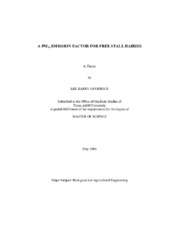| dc.contributor.advisor | Mukhtar, Saqib | |
| dc.contributor.advisor | Parnell, Calvin B | |
| dc.creator | Goodrich, Lee Barry | |
| dc.date.accessioned | 2006-08-16T19:06:33Z | |
| dc.date.available | 2006-08-16T19:06:33Z | |
| dc.date.created | 2002-05 | |
| dc.date.issued | 2006-08-16 | |
| dc.identifier.uri | https://hdl.handle.net/1969.1/3858 | |
| dc.description.abstract | Ambient concentration measurements of total suspended particulate (TSP) were made at
a commercial dairy in central Texas during the summers of 2002 and 2003. The facility
consisted of both open pen housing and free-stall structures to accommodate
approximately 1840 head of milking cattle. The field sampling results were used in the
EPA approved dispersion model Industrial Source Complex Short Term version 3
(ISCST-v3) to estimate emission fluxes and ultimately a seasonally corrected emission
factor for a free-stall dairy.
Ambient measurements of TSP concentrations for sampling periods ranging from 2 to 6
hours were recorded during the summer of 2002. The mean upwind concentration was
115µg/m3 with a maximum of 231µg/m3 and a minimum of 41.4µg/m3. The mean net
downwind TSP concentration was 134µg/m3 with a maximum of 491µg/m3 and a
minimum of 14µg/m3. Field sampling at this same dairy in the summer of 2003 yielded
significantly more 2 to 6 hour TSP concentration measurements. The mean upwind TSP
concentration was 76µg/m3 with a maximum concentration of 154µg/m3. The mean net downwind TSP concentration was 118µg/m3 with a maximum of 392µg/m3 and a
minimum of 30µg/m3.
The particle size distributions (PSD) of the PM on the downwind TSP filters was
determined using the Coulter Counter Multisizer. The results of this process was a
representative dairy PM PSD with 28% of TSP emissions being PM10.
The reported PM10 24-hour emission factors were 4.7 kg/1000hd/day for the free-stall
areas of the facility and 11.7 kg/1000hd/day for the open pen areas of the dairy. These
emission factors were uncorrected for rainfall events. Corrections for seasonal dust
suppression events were made for the San Joaquin Valley of California and the
panhandle region of Texas. Using historical rainfall and ET data for central California,
the seasonally corrected PM10 emission factor is 3.6kg/1000hd/day for the free-stalls,
and 8.7kg/1000hd/day for the open pens. For Texas, the seasonally corrected emission
factor is 3.7kg/1000hd/day for the free-stall areas and 9.2kg/1000hd/day for the open lot
areas. | en |
| dc.format.extent | 635755 bytes | en |
| dc.format.medium | electronic | en |
| dc.format.mimetype | application/pdf | |
| dc.language.iso | en_US | |
| dc.publisher | Texas A&M University | |
| dc.subject | Particulate matter | en |
| dc.subject | PM10 | en |
| dc.subject | dairy | en |
| dc.subject | emissions | en |
| dc.title | A PM10 emission factor for free stall dairies | en |
| dc.type | Book | en |
| dc.type | Thesis | en |
| thesis.degree.department | Biological and Agricultural Engineering | en |
| thesis.degree.discipline | Biological and Agricutural Engineering | en |
| thesis.degree.grantor | Texas A&M University | en |
| thesis.degree.name | Master of Science | en |
| thesis.degree.level | Masters | en |
| dc.contributor.committeeMember | Tomaszewski, Mike | |
| dc.type.genre | Electronic Thesis | en |
| dc.type.material | text | en |
| dc.format.digitalOrigin | born digital | en |


